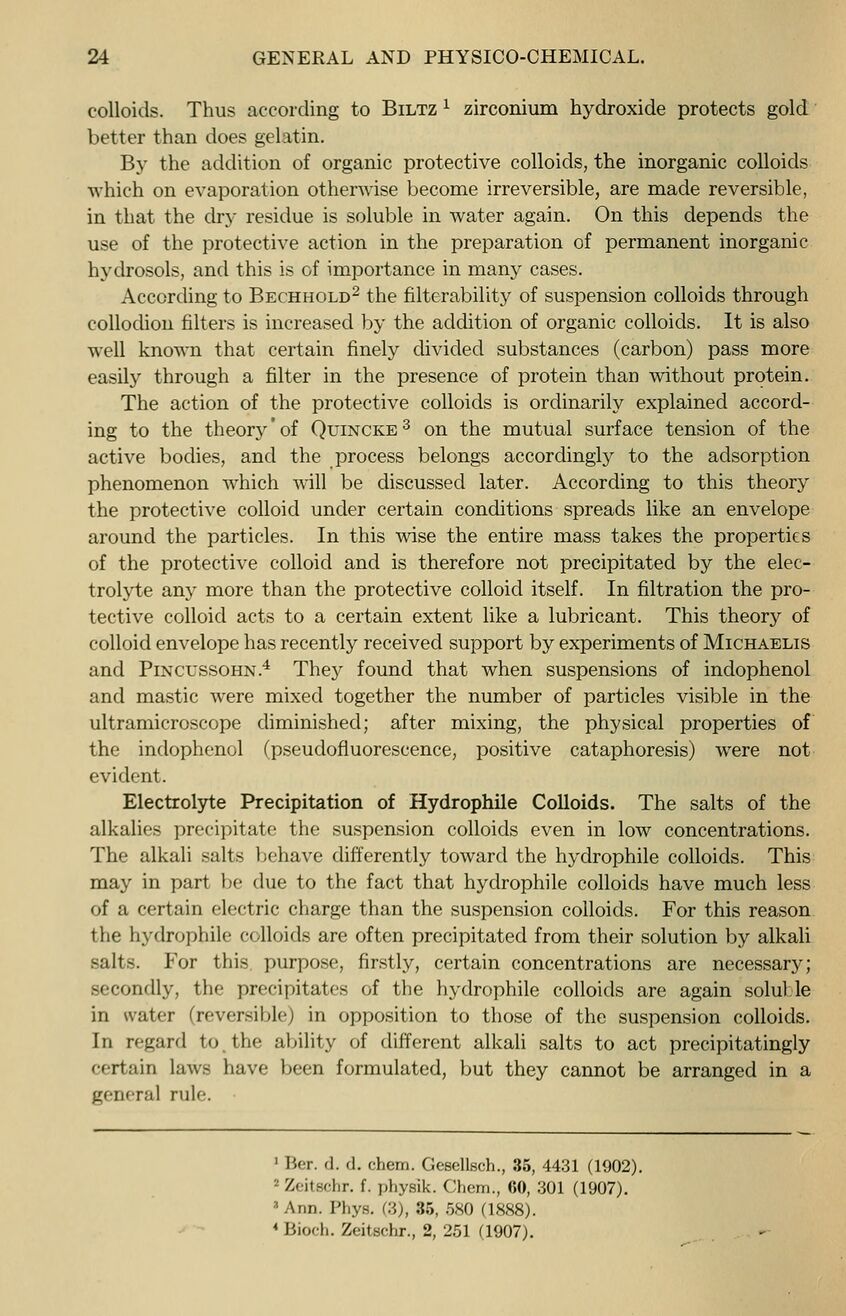
Full resolution (JPEG) - On this page / på denna sida - I. General and Physico-chemical - II. Colloids - Precipitation of the Colloids

<< prev. page << föreg. sida << >> nästa sida >> next page >>
Below is the raw OCR text
from the above scanned image.
Do you see an error? Proofread the page now!
Här nedan syns maskintolkade texten från faksimilbilden ovan.
Ser du något fel? Korrekturläs sidan nu!
This page has never been proofread. / Denna sida har aldrig korrekturlästs.
24 GENERAL AND PHYSICO-CHEMICAL.
colloids. Thus according to Biltz l
zirconium hydroxide protects gold
better than does gelatin.
By the addition of organic protective colloids, the inorganic colloids
which on evaporation otherwise become irreversible, are made reversible,
in that the dry residue is soluble in water again. On this depends the
use of the protective action in the preparation of permanent inorganic
hydrosols, and this is of importance in many cases.
According to Bechhold2
the filterability of suspension colloids through
collodion filters is increased by the addition of organic colloids. It is also
well known that certain finely divided substances (carbon) pass more
easily through a filter in the presence of protein than without protein.
The action of the protective colloids is ordinarily explained accord-
ing to the theor3r
’of Quincke 3
on the mutual surface tension of the
active bodies, and the process belongs accordingly to the adsorption
phenomenon which will be discussed later. According to this theory
the protective colloid under certain conditions spreads like an envelope
around the particles. In this wise the entire mass takes the properties
of the protective colloid and is therefore not precipitated by the elec-
trolyte any more than the protective colloid itself. In filtration the pro-
tective colloid acts to a certain extent like a lubricant. This theory of
colloid envelope has recently received support by experiments of Michaelis
and Pincussohn.4
They found that when suspensions of indophenol
and mastic were mixed together the number of particles visible in the
ultramicroscope diminished; after mixing, the physical properties of
the indophenol (pseudofluorescence, positive cataphoresis) were not
evident.
Electrolyte Precipitation of Hydrophile Colloids. The salts of the
alkalies precipitate the suspension colloids even in low concentrations.
The alkali salts behave differently toward the hydrophile colloids. This
may in part be due to the fact that hydrophile colloids have much less
of a certain electric charge than the suspension colloids. For this reason
the hydrophile colloids are often precipitated from their solution by alkali
salts. For this purpose, firstly, certain concentrations are necessary;
secondly, the precipitates of the hydrophile colloids are again solul le
in water (reversible) in opposition to those of the suspension colloids.
In regard to the ability of different alkali salts to act precipitatingly
certain laws have been formulated, but they cannot be arranged in a
general rule.
1
Ber. d. d. chem. Gesellsch., 35, 4431 (1902).
Zeitechr. f. physik. Chem., 60, 301 (1907).
’ Ann. I’liys. (3), 3.
r
>. 580 (1888).
1
Bioch. Zeitechr., 2, 251 (1907).
<< prev. page << föreg. sida << >> nästa sida >> next page >>